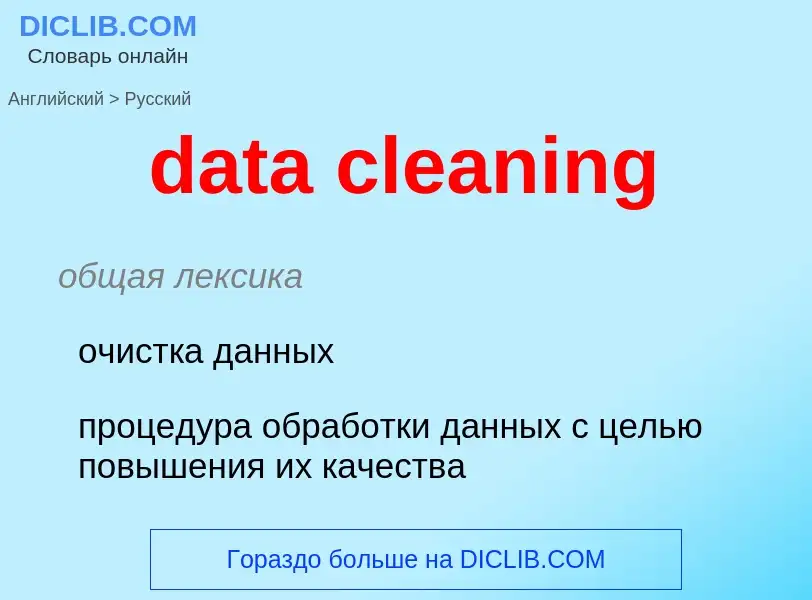Перевод и анализ слов искусственным интеллектом ChatGPT
На этой странице Вы можете получить подробный анализ слова или словосочетания, произведенный с помощью лучшей на сегодняшний день технологии искусственного интеллекта:
- как употребляется слово
- частота употребления
- используется оно чаще в устной или письменной речи
- варианты перевода слова
- примеры употребления (несколько фраз с переводом)
- этимология
data cleaning - перевод на Английский
общая лексика
очистка данных
процедура обработки данных с целью повышения их качества
Смотрите также
общая лексика
детергент
моющее средство
смывочный раствор
[drai'kli:niŋ]
существительное
общая лексика
химическая чистка
химчистка (процесс)
['kli:niŋ]
общая лексика
чистка
уборка
очистка
фильтрация
флотация
чистящий
очистительный
добыча полезных ископаемых
обогащение
выборка пустой породы
металлургия
зачистка (отливок)
прилагательное
общая лексика
очищающий
очистительный
существительное
['kli:niŋ]
общая лексика
(часто cleaning up)
чистка
уборка
очистка
чистка, уборка
сельское хозяйство
сортирование
отсортировка (семян)
прореживание
«проверка» (всходов)
добыча полезных ископаемых
обогащение
техника
осветление
Определение
Википедия
Data cleansing or data cleaning is the process of detecting and correcting (or removing) corrupt or inaccurate records from a record set, table, or database and refers to identifying incomplete, incorrect, inaccurate or irrelevant parts of the data and then replacing, modifying, or deleting the dirty or coarse data. Data cleansing may be performed interactively with data wrangling tools, or as batch processing through scripting or a data quality firewall.
After cleansing, a data set should be consistent with other similar data sets in the system. The inconsistencies detected or removed may have been originally caused by user entry errors, by corruption in transmission or storage, or by different data dictionary definitions of similar entities in different stores. Data cleaning differs from data validation in that validation almost invariably means data is rejected from the system at entry and is performed at the time of entry, rather than on batches of data.
The actual process of data cleansing may involve removing typographical errors or validating and correcting values against a known list of entities. The validation may be strict (such as rejecting any address that does not have a valid postal code), or with fuzzy or approximate string matching (such as correcting records that partially match existing, known records). Some data cleansing solutions will clean data by cross-checking with a validated data set. A common data cleansing practice is data enhancement, where data is made more complete by adding related information. For example, appending addresses with any phone numbers related to that address. Data cleansing may also involve harmonization (or normalization) of data, which is the process of bringing together data of "varying file formats, naming conventions, and columns", and transforming it into one cohesive data set; a simple example is the expansion of abbreviations ("st, rd, etc." to "street, road, etcetera").




![art conservation]] art conservation]]](https://commons.wikimedia.org/wiki/Special:FilePath/Conservation at the Church of Suceviţa.jpg?width=200)
![A shop assistant washing a shop window in [[Jyväskylä]], [[Finland]] in the 1960s. A shop assistant washing a shop window in [[Jyväskylä]], [[Finland]] in the 1960s.](https://commons.wikimedia.org/wiki/Special:FilePath/Kulutusosuuskuntien Keskusliiton kokoelma D1974 7644 (30878351716).jpg?width=200)
![[[Laundry]] in a river [[Laundry]] in a river](https://commons.wikimedia.org/wiki/Special:FilePath/Laundry in the river.jpg?width=200)

 3.jpg?width=200)





